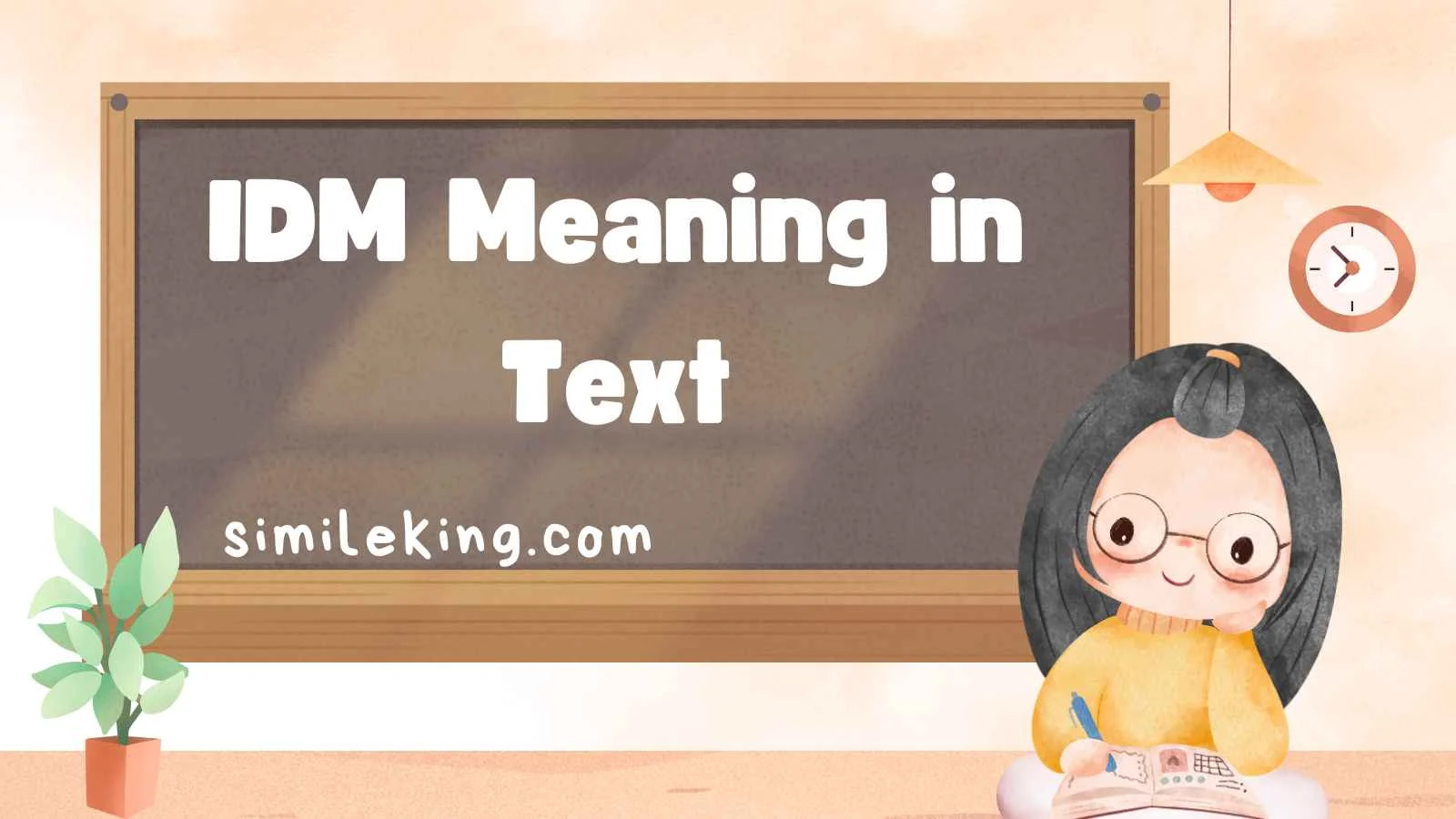The digital age has transformed the way we communicate. Abbreviations, acronyms, and internet shorthand are now an essential part of everyday texting, online conversations, and even professional emails. One abbreviation that often confuses people is IDM. You may have come across it in a chat, on social media, or in professional messages and wondered: What does IDM mean in text?
In this article, we’ll go far beyond the surface definition. You’ll learn:
- What IDM stands for in text.
- The different contexts where it is used (casual, professional, and slang).
- How its meaning changes depending on tone.
- Polite, professional, and casual alternatives you can use instead of IDM.
- 10 practical examples to help you apply it naturally in conversations.
- Tips to avoid misunderstandings when using abbreviations.
By the end, you’ll not only understand the IDM meaning in text, but also be equipped with advanced communication strategies that make you sound both natural and professional—online and offline.
What Does IDM Mean in Text?
In text conversations, IDM most commonly stands for:
- “I Don’t Mind.”
It’s a simple way to express flexibility, agreement, or a lack of preference. For example:
- Friend: “Do you want pizza or burgers tonight?”
- You: “IDM, you pick!”
Here, IDM shows that you are okay with any option and don’t have a strong opinion.
However, IDM is not limited to just this meaning. Depending on context, it may also stand for:
- Internet Download Manager (a software, but rarely used in casual text).
- I Do Music (used in creative or industry slang).
- Instant Direct Message (less common, but sometimes used on platforms like Discord or Slack).
Still, in texting and online chat, the overwhelmingly common meaning of IDM is “I Don’t Mind.”
Why People Use IDM in Text
Text messaging thrives on speed and brevity. Instead of writing “I don’t mind”, users save time with IDM. Here’s why it works:
- Efficiency – Shortens three words into three letters.
- Tone – Keeps conversations light and casual.
- Universality – Common enough that most people recognize it instantly.
- Neutrality – Doesn’t pressure the other person into making a specific choice.
Nuances of Tone When Using IDM
While IDM seems simple, its interpretation depends heavily on tone and context. Consider these situations:
- Polite/Professional
- “I can join the meeting at 2 pm or 3 pm, IDM.”
→ Shows flexibility without sounding passive.
- “I can join the meeting at 2 pm or 3 pm, IDM.”
- Casual/Friendly
- “IDM what movie we watch, just not horror lol.”
→ Keeps the tone light and informal.
- “IDM what movie we watch, just not horror lol.”
- Romantic/Personal
- “IDM where we go, as long as I’m with you.”
→ Adds warmth while still being flexible.
- “IDM where we go, as long as I’m with you.”
- Dismissive (to avoid)
- “IDM, whatever.”
→ Can come across as careless or uninterested.
- “IDM, whatever.”
👉 The key is: IDM works best when you genuinely mean you’re flexible—not when you want to avoid answering.
Professional Alternatives to IDM
In professional or formal contexts, abbreviations can sometimes feel too casual. Instead of “IDM,” you may want alternatives that carry the same meaning but sound more polished. Here are professional alternatives:
- “Either option works for me.”
- “I’m flexible with the timing.”
- “I don’t have a preference.”
- “I’m open to both choices.”
- “Whichever is convenient for you works.”
These phrases make you sound respectful and cooperative, especially in workplace emails or team discussions.
Casual Alternatives to IDM
When texting friends or chatting casually, you can mix things up instead of always saying IDM. Some casual alternatives include:
- “Anything’s fine.”
- “Doesn’t matter to me.”
- “Up to you!”
- “Whichever you want.”
- “I’m cool with whatever.”
These keep the vibe relaxed, while avoiding sounding robotic or repetitive.
Polite Alternatives to IDM
Politeness is key in conversations where you don’t want to sound dismissive. Instead of IDM, try:
- “I’ll go along with your choice.”
- “Whatever works best for you is fine.”
- “I’ll leave it up to you.”
- “I trust your judgment.”
- “Either way is good with me.”
These options communicate flexibility while adding a thoughtful, respectful touch.
How to Choose the Best Alternative
Choosing between IDM or one of its alternatives depends on who you’re talking to:
- Friends/Peers → Use IDM or casual alternatives like “up to you.”
- Work/Professional → Use polished alternatives like “I don’t have a preference.”
- Romantic/Personal → Add warmth, e.g., “Doesn’t matter as long as we’re together.”
- Formal Writing → Avoid abbreviations altogether.
10 Examples of IDM and Its Alternatives in Action
Here are 10 ready-to-use examples that show how IDM and its alternatives naturally fit into real-life situations:
- Casual – “Want to grab sushi or pizza tonight?” → “IDM, you pick.”
- Professional – “We can schedule the call for Monday or Tuesday.” → “Either option works for me.”
- Friendly – “Do you want to go shopping or just chill at home?” → “Doesn’t matter to me.”
- Polite – “Would you prefer tea or coffee?” → “Whatever works best for you is fine.”
- Romantic – “Where should we go this weekend?” → “Doesn’t matter as long as I’m with you.”
- Neutral – “Movie night? Comedy or action?” → “Up to you!”
- Respectful – “Would you like the presentation at the start or end of the meeting?” → “I’ll leave it up to you.”
- Friendly Group Chat – “Which game should we play later?” → “I’m cool with whatever.”
- Work Flexibility – “Do you want to lead this project or should I?” → “I trust your judgment.”
- Everyday Polite – “Would you like dinner at 7 or 8?” → “Either way is good with me.”
Common Mistakes When Using IDM
Even though IDM is easy, there are some pitfalls to avoid:
- Using IDM too often – It can make you seem passive or uninterested.
- Using IDM when you do care – Don’t say IDM if you actually prefer something.
- Sounding dismissive – Adding “whatever” can change IDM from polite to rude.
- Using it in formal writing – Avoid in essays, reports, or official emails.
- Assuming everyone knows it – Some people may not be familiar with IDM, especially older generations.
Final Thoughts
IDM meaning in text is “I don’t mind.” It’s a simple, efficient way to show flexibility, but like any abbreviation, its impact depends on tone and context.
- In casual chats, it’s perfectly fine to use IDM.
- In professional settings, opt for polished alternatives like “I don’t have a preference.”
- In personal relationships, soften it with warmth to avoid sounding dismissive.
The more thoughtfully you choose your words, the more natural and effective your communication will be.





